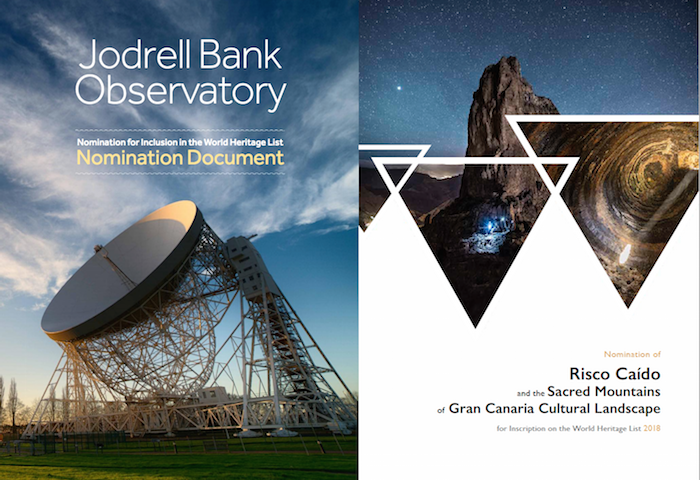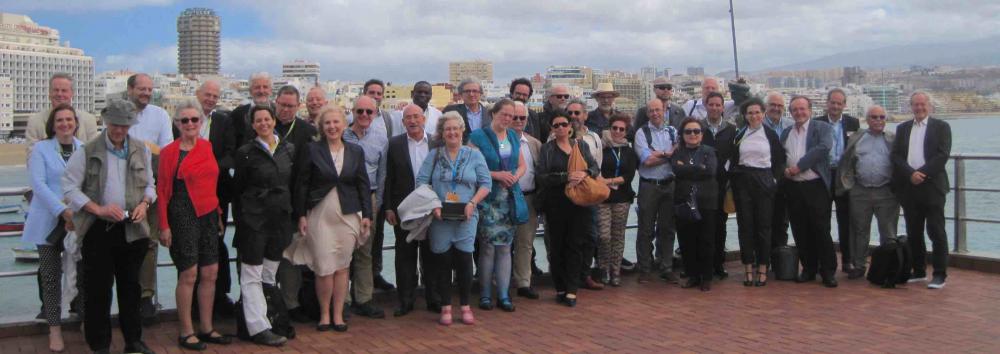Latest news

According to news reports, the Mount Wilson Observatory, together with NASA’s Jet Propulsion Laboratory (JPL), were saved from damage during the terrible fires of January 2025, despite the Eaton Fire reaching the edge of the Observatory’s grounds on January 9. The observatory, which housed the largest-aperture telescope in the world (100-inch Hooker) from 1917 until 1948 and was the location where Edwin Hubble discovered that the universe was expanding, remains in use for solar research as well as being a key focus for public outreach.
About Mount Wilson Observatory on this portal:
Photo: Aerial view of the Mount Wilson Observatory. In the lower-left are the 150ft and 60ft solar tower telescopes; in front is the horizontal Snow solar telescope. The domes of the 60-in and the 100-in Hooker telescope are visible behind. Photograph © Norm Vargas
Top news items from earlier years
2023
Four new astronomically related properties have been inscribed on the World Heritage List at the 45th (2023) session of the World Heritage Committee, held in Riyadh, Saudi Arabia, in September 2023:
Eise Eisinga planetarium, Netherlands
This moving mechanical scale model of the solar system is built into the ceiling and wall of the home of an ordinary citizen—its creator, Eise Eisinga, a Frisian wool-comber. Powered by a single pendulum clock, it provides a realistic image of the positions of the Sun, the Moon, the Earth, and the five planets Mercury, Venus, Mars, Jupiter and Saturn. The planets revolve around the Sun in real time and the distances between the planets are to scale.
Built between 1774 and 1781, and still in its original state, this remarkable orrery represents one of the earliest predecessors of the ceiling and projection planetariums of the 20th and 21st centuries.
Prehistoric sites of Talayotic Menorca, Spain
This serial (multi-site) property includes several taulas, arrangements of two large stone slabs bult into a “T”=shape enclosed within a walled enclosure, and facing its entrance. Constructed during the Bronze Age, these enigmatic monuments have a tightly clustered pattern of orientation around due south, apparently relating to the Southern Cross and other stars in the constellation Centaurus.
Hopewell ceremonial earthworks, Ohio, USA
The custom of mound building was widespread in eastern North America prior to European contact, and the Hopewell assemblage is characterized by enormous enclosures in the shape of circles, squares, and other clear-cut geometrical shapes, generally thought to have been built between about 200 BC and AD 400. A number of these include solstitial alignments: for example, along the diagonal axis of several square earthworks such as Hopeton, Hopewell, and Mound City, all of which are components of the serial property.
Many of the Hopewell earthworks have a fourfold symmetry and are cardinally or solstitially aligned. It has been suggested that circles and squares (or octagons) might themselves represent the earth and sky. When conjoined, as at Newark, they may have represented the whole universe in microcosm, defining spaces in which ceremonies or other activities could be performed that were suited to each realm.
Kazan and Engelhardt astronomical observatories, Russian Federation
Kazan Observatory was built in 1837 while Engelhardt Astronomical Observatory followed in 1898–1901. Its architecture and instrumentation reflects and represents the transition from classical astronomy to modern astrophysics.
2021
 Chankillo is inscribed on the World Heritage List
Chankillo is inscribed on the World Heritage List
The prehistoric solar observatory and ceremonial centre at Chankillo in Peru, including its famous thirteen towers, has been inscribed on the World Heritage List at the 44th (2021) session of the World Heritage Committee, held in Fuzhou, China, and on-line.
What has been hailed as the oldest solar observatory in the Americas is the second case study on this portal to have been inscribed on the World Heritage List in the last three years, following the successful inscrption of Risco Caído and the sacred mountains of Gran Canaria (Spain) in 2019. While that cultural landscape contained two important archaeoastronomical sites, Chankillo is the first property on the List to have been inscribed specifically as an “archaeoastronomical complex”.
According to UNESCO’s brief synthesis:
“The Chankillo solar observatory and ceremonial centre is a prehistoric site located on the north-central coast of Peru, in the Casma Valley, comprising a set of constructions in a desert landscape that, together with natural features, functioned as a calendrical instrument, using the sun to define dates throughout the seasonal year.
“The property includes a triple-walled hilltop complex, known as the Fortified Temple, two building complexes called Observatory and Administrative Centre, a line of thirteen cuboidal towers stretching along the ridge of s hill, and the Cerro Mucho Malo that complements the Thirteen Towers as a natural marker.”
 Chankillo has been inscribed under criteria (i) and (iv), as follows:
Chankillo has been inscribed under criteria (i) and (iv), as follows:
Criterion (i): “Chankillo archaeoastronomical complex is an outstanding example of ancient landscape timekeeping, a practice of ancient civilizations worldwide, which used visible natural or cultural features. Incorporated in the Thirteen Towers, it permitted the time of year to be accurately determined not just on one date but throughout the seasonal year. Unlike architectural alignments upon a single astronomical target found at many ancient sites around the world, the line of towers spans the entire annual solar rising and setting arcs as viewed, respectively, from two distinct observing points, one of which is still clearly visible above ground. The astronomical facilities at Chankillo represent a masterpiece of human creative genius.”
Criterion (iv): “Chankillo was in use for a relatively brief period of time between 250 and 200 BC, during a late phase of the Early Horizon Period (500–200 BC) of Peruvian prehistory, after which it was destroyed and abandoned. The Chankillo Compex is a very particular type of building representing an early stage in the development of native astronomy in the Americas. It shows great innovation by using the solar cycle and an artificial horizon to mark the solstices, the equinoxes, and every other date within the year with a precision of 1–2 days. The solar observatory at Chankillo is thus a testimony of the culmination of a long historical evolution of astronomical practices in the Casma Valley.”
2020
Thematic Study published in Japanese
Thanks to the efforts of translators Reizaburo Kitai, Hiroko Watanabe and Kumi Hirose, the ICOMOS–IAU Thematic Study on the Heritage Sites of Astronomy and Archaeoastronomy is now available in Japanese.
This Japanese version of the Thematic Study has been published by ICOMOS and can be downloaded free of charge.
Download the new Japanese edition (2022) [38Mb] ![]()
Download the original English edition (45Mb) ![]()
For further information on the two ICOMOS–IAU Thematic Studies on astronomical heritage, see here.
2019
Two new astronomical World Heritage Sites inscribed in 2019

The front covers of the nomination dossiers for the two new World Heritage Sites
Two very different places linked to astronomy have been inscribed on UNESCO’s World Heritage List at the 43rd World Heritage Committee session in Baku, Azerbaijan.
Jodrell Bank Observatory in the UK is the first 20th-century astronomical observatory to become a World Heritage Site. From its first use in 1945 through to the present day, various observing instruments have been constructed here as the field of radio astronomy developed. The most iconic of these is the Lovell Telescope, the first large fully steerable radio telescope in the world upon its completion in 1957, which still operates as the third largest on the planet. The bowl of this huge structure, 76m in diameter and standing 89m high, is a distinctive landmark that is visible for miles around.
While much of Jodrell’s early equipment has been demolished or re-used in subsequent instruments, a good deal survives either above or below ground, and this constitutes a tangible record of the progress of the history of radio astronomy from its inception right through to the present day. While still a working scientific institution, Jodrell Bank is also a popular tourist destination running numerous inspirational outreach activities at its Discovery Centre.
Risco Caído and the sacred mountains of Gran Canaria, Spain’s successful nomination for 2019, comprises a rugged and spectacular region in the interior of the third-largest island in the Canaries that was the sacred homeland of one of the most extraordinary and least known island cultures on the planet—one that evolved in total isolation over more than fifteen hundred years. The Caldera de Tejeda contains numerous structures built by the original inhabitants of Gran Canaria, many aligned with the rising and setting sun, particularly at the summer solstice and the equinoxes, together with artificial caves and other structures used for rituals and as astronomical markers to control the passage of time. This new World Heritage property is a “cultural landscape” not excusively relating to astronomy, but rather highlighting cultural astronomy operating in a rich historical and social context.

The Caldera de Tejeda. © Cabildo de Gran Canaria
Risco Caído and the sacred mountains of Gran Canaria is described in detail in a full case study on this portal.
These two inscriptions represent a successful outcome for the Astronomy and World Heritage Initiative, now ten years old, and it is hoped that more inscriptions of astronomical heritage sites will soon follow.
The last astronomical heritage inscriptions were both in 2010: The Jantar Mantar at Jaipur in India and Dengfeng Observatory in China, as part “Historic Monuments of Dengfeng in “The Centre of Heaven and Earth’ ”.
2018
Gran Canaria meeting brings together two UNESCO initiatives

An international expert meeting took place in Gran Canaria, Spain, on May 23–24, 2018 which brought together the Astronomy and World Heritage Initiative and UNESCO’s thematic initiative on Heritage of Religious Interest. The aim was to identify and reinforce the close linkages that exist across human cultures between religious/sacred traditions and celestial knowledge, and the clear connections between sacred sites and the skyscape. The meeting issued a set of recommendations aimed at recognising, respecting and helping to preserve such sites, including through the World Heritage process.
The recommendations

2017
Second Thematic Study on astronomical heritage

A second ICOMOS–IAU Thematic Study on the Heritage Sites of Astronomy and Archaeoastronomy was published in June 2017 in e-book form (see the TS2 contents page to download) and in November 2017 as a paperback,which can be purchased from Oxbow Books/Casemate Academic.
The case studies in TS2 include seven-stone antas (prehistoric dolmens) in Portugal and Spain, the thirteen towers of Chankillo in Peru, the astronomical timing of irrigation in Oman, Pic du Midi de Bigorre Observatory in France, Baikonur Cosmodrome in Kazakhstan, and Aoraki–Mackenzie International Dark Sky Reserve in New Zealand. A case study on Stonehenge, already a World Heritage Site, focuses on preserving the integrity of the solstitial sightlines. A thematic chapter and several case studies address the issue of recognising dark sky values in relation to the broader cultural or natural values of a place. See here for more details.






